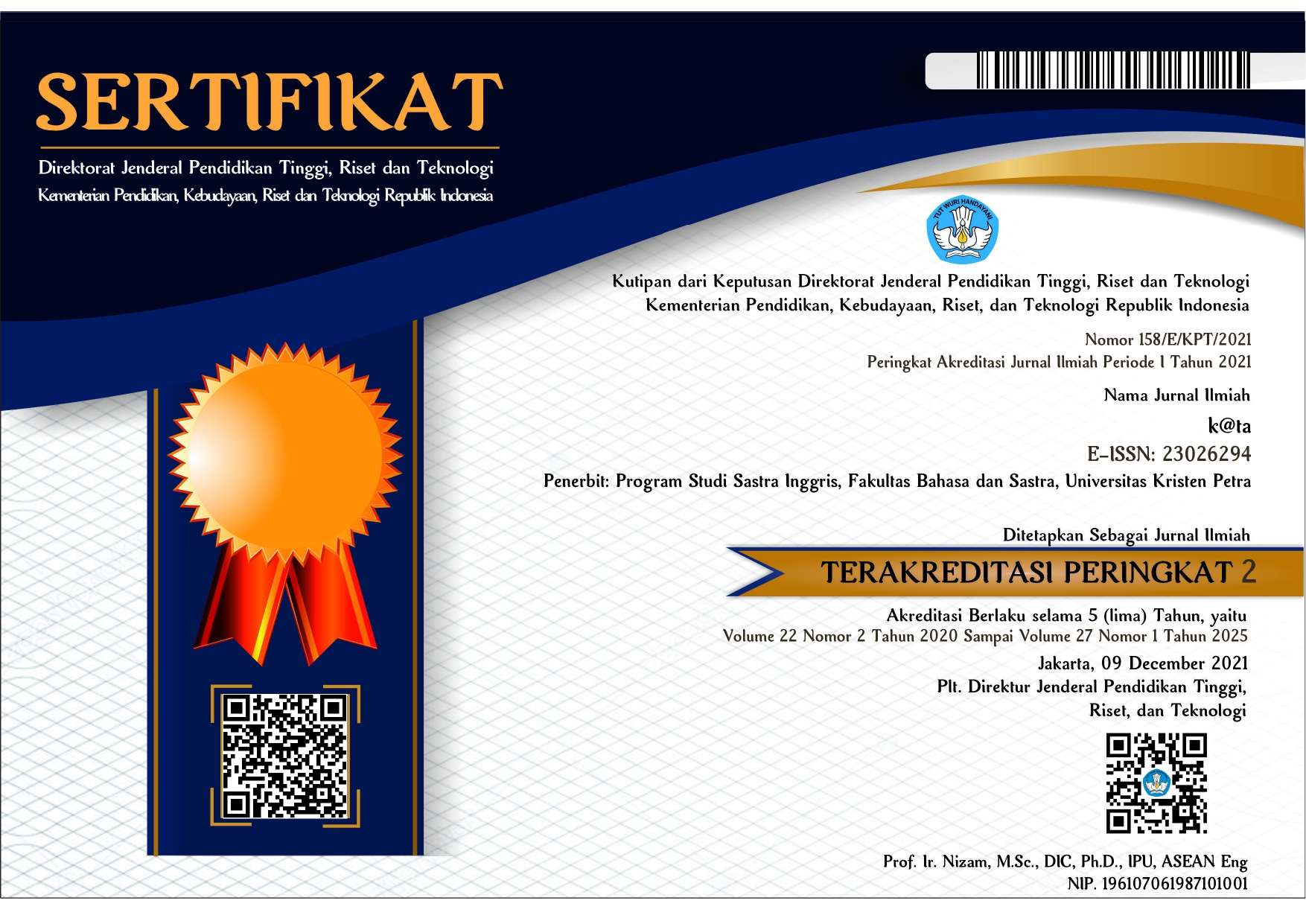A Study of Gender Performativity in Virginia Woolf’s Orlando: A Mocking Biography
DOI:
https://doi.org/10.9744/kata.18.1.1-7Keywords:
Virginia Woolf, Orlando, androgyny, bisexuality, gender performativityAbstract
ABSTRACT
The present paper aims at concentrating on Judith Butler’s theory of gender as performance and how Virginia Woolf challenges the assumptions of heterosexuality in Virginia Woolf’s Orlando(1992). Woolf rebels against the traditional view of gender as two separate categories by presenting Orlando as an androgynous and bisexual character. Orlando’s transformation from male to female and exhibition of the characteristics of both feminity and masculinity expose how gender norms are socially instituted. Woolf portrays Orlando’s attraction to both men and women. He/she loves Sasha regardless of what changes her body undergoes, but he/she marries Shelmerdine because he/she is bisexual. Woolf also shows clothing as signifiers of the social construction of gender and how characters flout this convention by using cross dressing.
Keywords: Virginia Woolf, Orlando, androgyny, bisexuality, gender performativity
Downloads
References
REFERENCES
Burrells, A., Ellis,S., Parsons,D., & Simpson, K. (2007). Woolfian Boundaries Selected Papers
From the Sixteenth Annual International Conference on Virginia Woolf. Clemson:
Clemson University Digital Press.
Butler, J. (1997). The Psychic Life of Power: Theories in Subjection, Stanford: Stanford
University Press.
______. (1999). Gender Trouble. New York and London: Routledge.
______ . (2011). Bodies That Matter. New York and London: Routledge.
Caughie, P.L. (1989). VirginiaWoolf’s Double Discourse. In MarleenS. Barr & Richard
Feldstein. (Eds.), Discontented Discourses: Feminism/textual Intervention/psychoana-
Lysis (pp. 41-53.) Urbana, IL: University of Illinois Press.
Caughie, P. L. (1991). Virginia Woolf & Postmodernism: Literature in Quest & Question of
Itself . Urbana: University of Illinois Press.
Cosgrove, S. E. (2011). Radical Uncertainty: Judith Butler and a theory of character. In J.
Conway Herron(Eds.), The Ethical Imaginations: Writing Worlds Papers –The Refereed
Proceedings of the16th Conference of the Australasian Association of Writing proram
(pp.1-8). M. Costello & L. Hawryluk. Byron Bay: Australian Association of Writing Prog-
rams.
Hargreaves, T. (2005). Androgyny in Modern Literature, Great Britain: Antony Rowe Ltd,
Chiham and Eastbourne.
Howard, Stephen. (2007). The Lady in the Looking-Glass: Reflections on the Self in
Virginia Woolf. Journal of International Women's Studies. 8(2), 44-54.
Lee, H. (1977). The Novels of Virginia Woolf. London: Methuen & Co Ltd.
Lee, H. (1996). Biomythographers: Rewriting the Lives of Virginia Woolf. Essays in Criticism.
XLVI (2), 95-114. doi: 10.1093/eic/XLVI.2.95.
Mansfield, N. (2000). Subjectivity: Theories of the Self from Freud to Haraway. Australia:
Allen &Unwin.
Marcus, L. (2006). Woolf's Feminism and Feminism's Woolf. In Sue Roe and Susan Sellers.
(Eds.), The Cambridge Companion to Virginia Woolf (pp. 209-44). Cambridge: Cambridge
UP.
McDaniel, J. L. (2012). The Power of Renewable Resources: Orlando’s Tactical Engagement
with the Law of Intestacy. Gender & History, 24, 718–34. doi:10.1111/j.14680424.2012.
x.
McNamara, S. (2011). Seduction and Revenge in Virginia Woolf's Orlando. The Psycho-
Analytic Quarterly, LXXX , 619–41. doi: 10.1002/j.2167-4086.2011.tb00099.x.
Ronchetti, A. (2004). The Artist, Society & Sexuality In Virginia Woolf’s Novels. New York&
London: Routledge .
Salih, S. (2002). Judith Butler. London and New York: Routledge.
Woolf, V. (1977). A Room of One's Own. Grafton: Harper Collins.
_______ . (1992). Orlando A Biography. Great Britain: Oxford University Press.
Downloads
Published
How to Cite
Issue
Section
License
![]() This work is licensed under a Creative Commons Attribution License
This work is licensed under a Creative Commons Attribution License


.png)
.png)

















